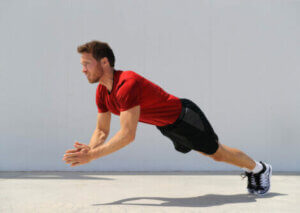5 Benefits of Plyometric Exercises

There are many different types of exercise, and each one is good for developing a different aspect of your physique or physical abilities. But today, we’re going to look at the benefits of plyometric exercises, which can be quite good for you despite not being very well known.
Does the word plyometric even ring any bells? If not, don’t worry. We’ll explain everything below and tell you how they can be beneficial for you.
What are plyometric exercises?
Plyometric exercises are first and foremost impact exercises, and they mainly consist of lunges and leaps. As a result, they help develop your strength, speed, and power.
Plyometric exercises involve fast and powerful muscle contractions, and, with practice, this helps increase your muscle power.
This sort of exercise is normally used by professional athletes who need to increase their power in order to compete. Some of the most common sports that can benefit from this type of training include volleyball, basketball, soccer, and track and field.
Plyometric exercises are a form of high-intensity training that involves starting with the muscle fully extended only to then contract it quickly and with power.
Examples of plyometric exercises
Here are some of the most well-known plyometric exercises:
- Squat jumps – This involves performing a normal squat but jumping instead of straightening the legs gradually as normal.
- Long jump – Starting in a squatting position, jump forward as far as you can, swinging your arms forward for more momentum.
- Plyometric push-ups – This is just like a normal push-up, except instead of slowly raising your body, you need to push with your arms to spring upwards and clap before returning to the starting position.

Benefits of plyometric exercises
Although they’re mainly based on jumps and lunges, there’s still a wide variety of different plyometric exercises so you won’t get bored with them. Here are just some of the benefits of regularly performing plyometric exercises.
1. They strengthen the muscles
One of the main benefits of plyometric exercises is that they help build your strength. Furthermore, they can help develop various different muscle groups.
By increasing your strength and reaction speed with regular training, your muscles will begin to gradually grow and strengthen.
2. They increase your speed
As well as increasing your strength, these exercises also help you to move faster by working the muscles involved in certain body movements.
These exercises help develop speed, acceleration, and reaction speed, which is why so many professional and amateur athletes do them.
3. They help develop other physical abilities
These exercises aren’t just about strength and speed. They also help develop your balance and coordination and many other aspects.
This is because these exercises require a great deal of agility and dexterity. Although they might be difficult at first, over time, you’ll note a significant difference in your balance and coordination.
4. They help prevent injuries
In principle, plyometric exercises are impact-based, so they help the body get used to such impacts. Furthermore, the muscles that are worked help protect the relevant joints.
Along with this, your ligament and tendons will also strengthen as your muscle mass increases. All of this makes your body much more resistant to injury.

5. You don’t need any equipment to do them
As an extra plus, you don’t need anything other than the space to perform these exercises. That makes it a really easy form of bodyweight training that you can do anywhere, any time.
Reasons not to do plyometric exercises
Despite all of the benefits that these exercises can bring, there are some people who should probably avoid them.
If you’re overweight or not used to physical exercise, don’t start off with plyometric exercises. The impact of these exercises could cause an injury if you’re not already in reasonable shape.
Ultimately, it’s always best to consult a professional before starting any training routine. Every person is different and has different needs, so arrange a visit to your doctor for a check-up before you start.
There are many different types of exercise, and each one is good for developing a different aspect of your physique or physical abilities. But today, we’re going to look at the benefits of plyometric exercises, which can be quite good for you despite not being very well known.
Does the word plyometric even ring any bells? If not, don’t worry. We’ll explain everything below and tell you how they can be beneficial for you.
What are plyometric exercises?
Plyometric exercises are first and foremost impact exercises, and they mainly consist of lunges and leaps. As a result, they help develop your strength, speed, and power.
Plyometric exercises involve fast and powerful muscle contractions, and, with practice, this helps increase your muscle power.
This sort of exercise is normally used by professional athletes who need to increase their power in order to compete. Some of the most common sports that can benefit from this type of training include volleyball, basketball, soccer, and track and field.
Plyometric exercises are a form of high-intensity training that involves starting with the muscle fully extended only to then contract it quickly and with power.
Examples of plyometric exercises
Here are some of the most well-known plyometric exercises:
- Squat jumps – This involves performing a normal squat but jumping instead of straightening the legs gradually as normal.
- Long jump – Starting in a squatting position, jump forward as far as you can, swinging your arms forward for more momentum.
- Plyometric push-ups – This is just like a normal push-up, except instead of slowly raising your body, you need to push with your arms to spring upwards and clap before returning to the starting position.

Benefits of plyometric exercises
Although they’re mainly based on jumps and lunges, there’s still a wide variety of different plyometric exercises so you won’t get bored with them. Here are just some of the benefits of regularly performing plyometric exercises.
1. They strengthen the muscles
One of the main benefits of plyometric exercises is that they help build your strength. Furthermore, they can help develop various different muscle groups.
By increasing your strength and reaction speed with regular training, your muscles will begin to gradually grow and strengthen.
2. They increase your speed
As well as increasing your strength, these exercises also help you to move faster by working the muscles involved in certain body movements.
These exercises help develop speed, acceleration, and reaction speed, which is why so many professional and amateur athletes do them.
3. They help develop other physical abilities
These exercises aren’t just about strength and speed. They also help develop your balance and coordination and many other aspects.
This is because these exercises require a great deal of agility and dexterity. Although they might be difficult at first, over time, you’ll note a significant difference in your balance and coordination.
4. They help prevent injuries
In principle, plyometric exercises are impact-based, so they help the body get used to such impacts. Furthermore, the muscles that are worked help protect the relevant joints.
Along with this, your ligament and tendons will also strengthen as your muscle mass increases. All of this makes your body much more resistant to injury.

5. You don’t need any equipment to do them
As an extra plus, you don’t need anything other than the space to perform these exercises. That makes it a really easy form of bodyweight training that you can do anywhere, any time.
Reasons not to do plyometric exercises
Despite all of the benefits that these exercises can bring, there are some people who should probably avoid them.
If you’re overweight or not used to physical exercise, don’t start off with plyometric exercises. The impact of these exercises could cause an injury if you’re not already in reasonable shape.
Ultimately, it’s always best to consult a professional before starting any training routine. Every person is different and has different needs, so arrange a visit to your doctor for a check-up before you start.
All cited sources were thoroughly reviewed by our team to ensure their quality, reliability, currency, and validity. The bibliography of this article was considered reliable and of academic or scientific accuracy.
- Leceaga, J., Los Arcos, A., Castillo Alvira, D., & Yanci, J. (2017). Influencia del volumen de entrenamiento pliométrico en la carga percibida diferenciada de futbolistas de alto nivel. Pensar En Movimiento: Revista de Ciencias Del Ejercicio y La Salud. https://doi.org/10.15517/pensarmov.v15i2.27664
- Martínez-rodríguez, A., Mira-alcaraz, J., Cuestas-calero, B. J., Pérez-turpín, J. A., & Pedro, E. (2017). La Pliometría en el Voleibol Femenino. Revisión Sistemática. RETOS. Nuevas Tendencias En Educación Física, Deporte y Recreación.
- Quetglas, Z., Iglesia, O., & Martinez, R. (2012). Fundamentos biomecánicos del ejercicio pliométrico. Lecturas: Educación Física y Deportes, Revista Digital.
This text is provided for informational purposes only and does not replace consultation with a professional. If in doubt, consult your specialist.








